Why do we need "tailed" cars?
Recently, more and more you can meet concepts with active aerodynamics. On real cars use active spoilers, and fender with a variable angle of attack. All developments implemented in the "metal" of these cars, are used to improve handling and downforce.
Fuel economy due to the active change in the shape of the car can be found only on concepts like the Renault EOLAB, and Mersedes Benz IAA.
The development of "active aerodynamics", however, is not limited to passenger cars.
')

For example, the device Trailer Tail ("tail" of the semi-trailer) from ATDynamics (USA) is already used by more than 12,000 road trains.

In fact, this is a set of fairings for installation on the rear side of a standard semi-trailer. Its installation in ATP conditions takes no more than an hour for any trailer. When parked or before loading and unloading the cargo, the “tail” is folded in a few minutes without using any tool, and fixed. When driving over the rear of the semi-trailer, the tail panels are easily deformed, and then they also easily restore their shape, as they are made of a composite with special. properties.

A different approach to solving the problem of stall flow and turbulence behind the semitrailer was applied at ATS (Aerodynamic Trailer Systems, USA).
They used an inflatable "tail" design - a SmartTrail spoiler (having electronic control) that automatically unfolds or folds while the train is moving.
The device consists of:
The mass of the entire device is 59 kg. width 500 ... 610 mm.
The benefits of the SmartTrail spoiler are:
In addition to the “tails” in the Freight and Bus engineering, spoilers are often used, and various linings with the main goal - fuel economy. Still, with huge traffic volumes, a “licked” brick, even with a few percent of savings, brings tangible financial benefits.
In cars, the theme of "activity" is now only gaining momentum. A very interesting example is the Mersedes Benz IAA.
Many people probably heard about “active” wheel covers before (even there was a patent for such a design in the USSR, but there was a simple design, mainly for better brake cooling). Other elements here already have a more modern "history". The IAA concept has two modes of vehicle condition: “design mode” and “aerodynamic mode”. The second mode allowed to reduce the drag coefficient (Cx) from 0.25 to 0.19. When driving after reaching 80 km / h, an automatic transition to the aerodynamic mode is provided.

The tail in aero mode is extended to 390 mm, and consists of eight special shields.
To date, attempts are being made to similar refinement of cars with their own hands. For example - Darin Cosgrove (Darin Cosgrove), conducted the simplest experiment on his Pontiac Firefly. He attached to him a peculiar tail, rumored to be made mostly of scotch tape and cardboard, 137 cm long.
The result of "tuning" was good - Cx dropped from 0.34 to 0.23, and consumption at a speed of 90 km / h fell by 15%. To prove such figures, the experimenter drove three segments according to the scheme ABA (with a tail, without it, and again with it). The test coincided with the calculation, taking into account the error in temperature and wind in these segments, thus it was proved that the presence of an elongated rear section can improve aerodynamics. By the way, similar studies were conducted back in the 50s, but there, due to the poor aerodynamics of the front of the car, the effect was not always great.
Further on the site were other "homemade" with great potential, but dubious practicality. "Tails" for pickups, and other machines.
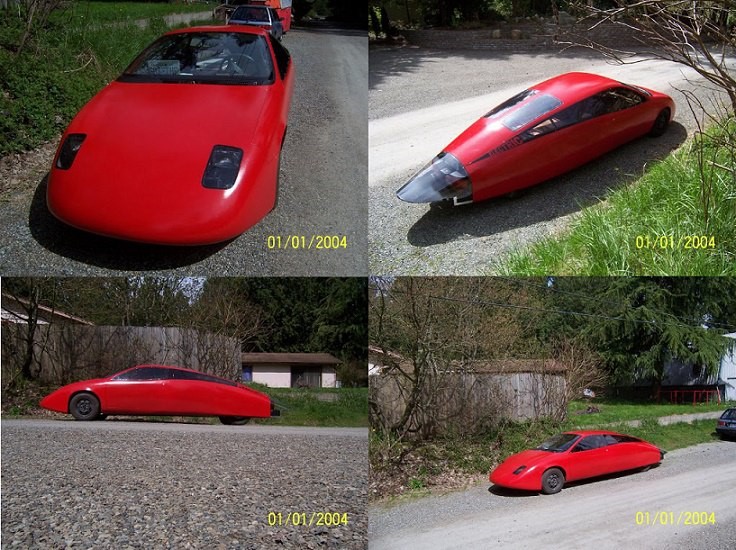
There was a similar "tail" tuning and the concept of the USSR!
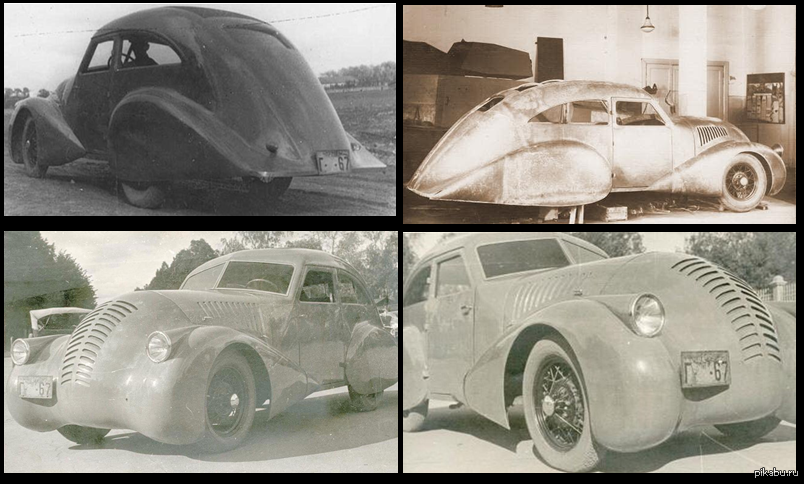
This car is a former GAZ-A, reworked by Alexei Nikitin with the greatest possible approximation to the ideal form - a drop of liquid. The result of his work was impressive - the drag coefficient (Cx) decreased by 2 times, compared to the original GAZ A. The maximum speed also increased to 106 km / h.
Next were the aerodynamic "rockets" based on the "Victory".


Aviator Alexey Smolin created a record car based on the GAZ M20 Victory in the 50s. The roof was lowered, and fairings made of duralumin appeared in front and behind. Wheels got shields, and the "tail" was stretched into a cone. In addition, the engine was modified, and the bottom is covered with a smooth pan. The car could develop already 190 km / h!
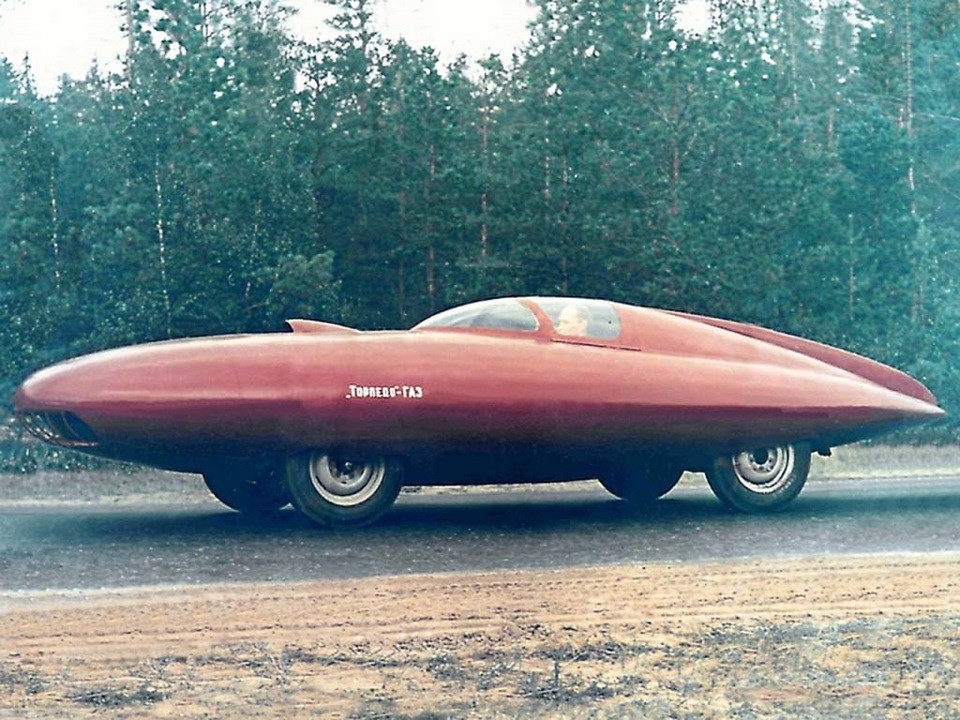
Next was the most insane project Gas Torpedo. Here the idea of dropletness has been maximized.
In our time, a partial example of the revival of enthusiasm for streamlined machines can be considered the "Biodesign" of the 90s, and some modern analogs of specific concepts.
In general, the idea of the tail is already quite “bearded”, and perhaps soon it will survive the renaissance again. Still, the current trend towards an increase in sales of crossovers and microcars simply leaves no choice in improving aerodynamics, because the back part is an important element determining the aerodynamics of a car. Here the score is not in the hundredth, but in the tenths of Cx.
Passion for hatchbacks and liftbacks slightly improved the situation, but in terms of maximizing the use of space, there is no better form than a station wagon, but this particular form is much worse in an aerodynamic sense. Behind the machine with this form factor, a large vacuum zone is formed, which increases the resistance to movement. Also in the zone of turbulence is sucked in a lot of dirt, polluting the rear window.
"Tail" on the wagon may well solve these problems, and bring additional benefits.
The fact is that in Russia, and the same USA-Canada, there are many long straight sections of roads for 200-400 km, where the installation of the “tail” most likely will not be a problem for other road users. Thus, having attached this aerodynamic element to the car before a long, long journey, it would be possible to save fuel (energy) quite well. If we take into account the experience of cargo aerodynamic elements, then such constructions could well be partially inflatable (in order to occupy a minimum of space in the folded state).
Considering that the greatest effect will be achieved with the help of the tail, along the length of the greater length of the car itself, then it is logical to use an additional point of support for the tail (trailer) as a solution to the problem, and the folding of the "tail" may well be telescopic.
There are even original examples ...

Electric car with a variable area of the solar panel from Alexander Leonidovich Mukhanov (patent number 2053142).
The solar panel in the process of movement is extended according to the principle of a telescopic folding bed. When cornering and in some driving modes, the length is minimal, while on the road and on long stands - the maximum length.
Since this device will be needed only to improve aerodynamics, the depreciation may well be electronically controlled.

Under the conditions of the city, with the tail folded, it will occupy as much space as a regular trailer, and with further modifications it may be less.
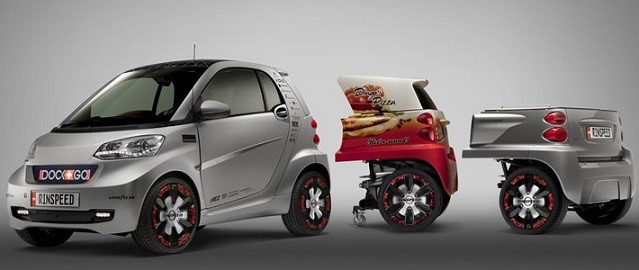
An example is the Dock + Go concept with several versions of trailer modules.
Of course, with the massive use of such structures, questions of a legislative nature will arise. The maximum length of the “tail” on cars of various classes will have to be limited so that overtaking such cars is not a problem, but most likely with an “active” change in length in motion, this will apply only to certain sections of the road and certain road conditions in the process of movement.
Passive safety from such a device will also benefit, since when hitting the rear with the “tail” extended, the collapse zone will be many times larger (as a rule, the inertia of the rear impact, unlike the impact from the front, is equivalent to almost impossible to reduce).
The review behind can quite replace a good rear-view camera (which will be much more reliable and better than the huge glass that needs to be warmed up and wiped and cleaned by the janitor). Even a possible disadvantage in the form of increased windage can be partially leveled due to the resistance of the supporting wheels of the “tail”, since without them the turning moment will be a serious problem with side wind.
PS - I think that with time, such constructions will be transferred from the category of homemade products to a completely standard tuning element (as it was at one time with spoilers, rear wings and body kits), but for now there are only patents from automakers.
So in the United States a patent was registered from Toyota for the strange design of a telescopic device to increase the aerodynamic efficiency of the car.
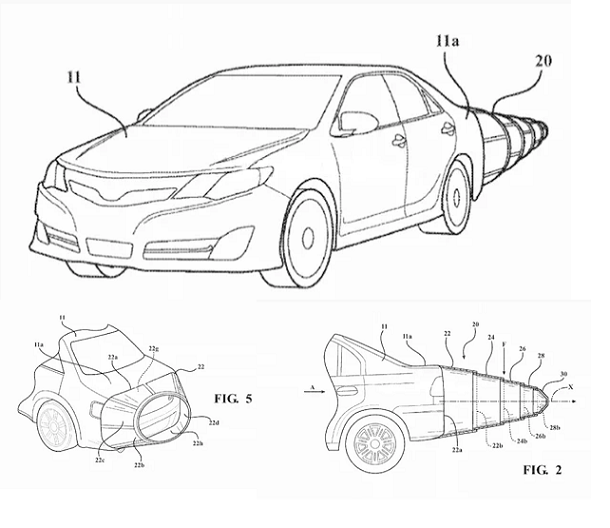
The patent was first filed with TEMA, a division of research and development of Toyota in North America, back in 2016, but was published only in 2018! He describes a flattened telescopic mechanism for reducing air resistance, which would reduce aerodynamic air resistance.
Fuel economy due to the active change in the shape of the car can be found only on concepts like the Renault EOLAB, and Mersedes Benz IAA.
The development of "active aerodynamics", however, is not limited to passenger cars.
')

For example, the device Trailer Tail ("tail" of the semi-trailer) from ATDynamics (USA) is already used by more than 12,000 road trains.

In fact, this is a set of fairings for installation on the rear side of a standard semi-trailer. Its installation in ATP conditions takes no more than an hour for any trailer. When parked or before loading and unloading the cargo, the “tail” is folded in a few minutes without using any tool, and fixed. When driving over the rear of the semi-trailer, the tail panels are easily deformed, and then they also easily restore their shape, as they are made of a composite with special. properties.

A different approach to solving the problem of stall flow and turbulence behind the semitrailer was applied at ATS (Aerodynamic Trailer Systems, USA).
They used an inflatable "tail" design - a SmartTrail spoiler (having electronic control) that automatically unfolds or folds while the train is moving.
The device consists of:
- Inflatable spoiler, quilted petals of which are made of a very flexible thermoplastic composite, and the top polymer coating. This design ensures tightness and good aerodynamics, as well as ease of cleaning and resistance to sticking of snow (and the formation of ice).
- Two air pumps (one for pressurizing the “tail” and the other for pumping air). The pumps operate automatically depending on the speed of the train.
- Control system (on-board microcomputer) with GPS. The functions of this system are regulation of the “tail” operation depending on the speed of movement and complete folding for opening the semitrailer doors. The system also takes into account the height above sea level, the temperature of the surrounding air, the speed, and the direction of the wind.
The mass of the entire device is 59 kg. width 500 ... 610 mm.
The benefits of the SmartTrail spoiler are:
- 4 ... 7% fuel economy;
- Automatically shrinks when reversing, without affecting the length of the train in cramped parking conditions;
- Does not require constant maintenance, as there are no moving mechanical parts exposed to rain, snow and ice.
In addition to the “tails” in the Freight and Bus engineering, spoilers are often used, and various linings with the main goal - fuel economy. Still, with huge traffic volumes, a “licked” brick, even with a few percent of savings, brings tangible financial benefits.
In cars, the theme of "activity" is now only gaining momentum. A very interesting example is the Mersedes Benz IAA.
Many people probably heard about “active” wheel covers before (even there was a patent for such a design in the USSR, but there was a simple design, mainly for better brake cooling). Other elements here already have a more modern "history". The IAA concept has two modes of vehicle condition: “design mode” and “aerodynamic mode”. The second mode allowed to reduce the drag coefficient (Cx) from 0.25 to 0.19. When driving after reaching 80 km / h, an automatic transition to the aerodynamic mode is provided.

The tail in aero mode is extended to 390 mm, and consists of eight special shields.
To date, attempts are being made to similar refinement of cars with their own hands. For example - Darin Cosgrove (Darin Cosgrove), conducted the simplest experiment on his Pontiac Firefly. He attached to him a peculiar tail, rumored to be made mostly of scotch tape and cardboard, 137 cm long.
The result of "tuning" was good - Cx dropped from 0.34 to 0.23, and consumption at a speed of 90 km / h fell by 15%. To prove such figures, the experimenter drove three segments according to the scheme ABA (with a tail, without it, and again with it). The test coincided with the calculation, taking into account the error in temperature and wind in these segments, thus it was proved that the presence of an elongated rear section can improve aerodynamics. By the way, similar studies were conducted back in the 50s, but there, due to the poor aerodynamics of the front of the car, the effect was not always great.
Further on the site were other "homemade" with great potential, but dubious practicality. "Tails" for pickups, and other machines.

There was a similar "tail" tuning and the concept of the USSR!

Gas-A-Aero (1934)
This car is a former GAZ-A, reworked by Alexei Nikitin with the greatest possible approximation to the ideal form - a drop of liquid. The result of his work was impressive - the drag coefficient (Cx) decreased by 2 times, compared to the original GAZ A. The maximum speed also increased to 106 km / h.
Next were the aerodynamic "rockets" based on the "Victory".


GAZ-SG1
Aviator Alexey Smolin created a record car based on the GAZ M20 Victory in the 50s. The roof was lowered, and fairings made of duralumin appeared in front and behind. Wheels got shields, and the "tail" was stretched into a cone. In addition, the engine was modified, and the bottom is covered with a smooth pan. The car could develop already 190 km / h!

Next was the most insane project Gas Torpedo. Here the idea of dropletness has been maximized.
In our time, a partial example of the revival of enthusiasm for streamlined machines can be considered the "Biodesign" of the 90s, and some modern analogs of specific concepts.
In general, the idea of the tail is already quite “bearded”, and perhaps soon it will survive the renaissance again. Still, the current trend towards an increase in sales of crossovers and microcars simply leaves no choice in improving aerodynamics, because the back part is an important element determining the aerodynamics of a car. Here the score is not in the hundredth, but in the tenths of Cx.
Passion for hatchbacks and liftbacks slightly improved the situation, but in terms of maximizing the use of space, there is no better form than a station wagon, but this particular form is much worse in an aerodynamic sense. Behind the machine with this form factor, a large vacuum zone is formed, which increases the resistance to movement. Also in the zone of turbulence is sucked in a lot of dirt, polluting the rear window.
"Tail" on the wagon may well solve these problems, and bring additional benefits.
The fact is that in Russia, and the same USA-Canada, there are many long straight sections of roads for 200-400 km, where the installation of the “tail” most likely will not be a problem for other road users. Thus, having attached this aerodynamic element to the car before a long, long journey, it would be possible to save fuel (energy) quite well. If we take into account the experience of cargo aerodynamic elements, then such constructions could well be partially inflatable (in order to occupy a minimum of space in the folded state).
Considering that the greatest effect will be achieved with the help of the tail, along the length of the greater length of the car itself, then it is logical to use an additional point of support for the tail (trailer) as a solution to the problem, and the folding of the "tail" may well be telescopic.
There are even original examples ...

Electric car with a variable area of the solar panel from Alexander Leonidovich Mukhanov (patent number 2053142).
The solar panel in the process of movement is extended according to the principle of a telescopic folding bed. When cornering and in some driving modes, the length is minimal, while on the road and on long stands - the maximum length.
Since this device will be needed only to improve aerodynamics, the depreciation may well be electronically controlled.

Under the conditions of the city, with the tail folded, it will occupy as much space as a regular trailer, and with further modifications it may be less.

An example is the Dock + Go concept with several versions of trailer modules.
Of course, with the massive use of such structures, questions of a legislative nature will arise. The maximum length of the “tail” on cars of various classes will have to be limited so that overtaking such cars is not a problem, but most likely with an “active” change in length in motion, this will apply only to certain sections of the road and certain road conditions in the process of movement.
Passive safety from such a device will also benefit, since when hitting the rear with the “tail” extended, the collapse zone will be many times larger (as a rule, the inertia of the rear impact, unlike the impact from the front, is equivalent to almost impossible to reduce).
The review behind can quite replace a good rear-view camera (which will be much more reliable and better than the huge glass that needs to be warmed up and wiped and cleaned by the janitor). Even a possible disadvantage in the form of increased windage can be partially leveled due to the resistance of the supporting wheels of the “tail”, since without them the turning moment will be a serious problem with side wind.
PS - I think that with time, such constructions will be transferred from the category of homemade products to a completely standard tuning element (as it was at one time with spoilers, rear wings and body kits), but for now there are only patents from automakers.
So in the United States a patent was registered from Toyota for the strange design of a telescopic device to increase the aerodynamic efficiency of the car.

The patent was first filed with TEMA, a division of research and development of Toyota in North America, back in 2016, but was published only in 2018! He describes a flattened telescopic mechanism for reducing air resistance, which would reduce aerodynamic air resistance.
Source: https://habr.com/ru/post/421253/
All Articles